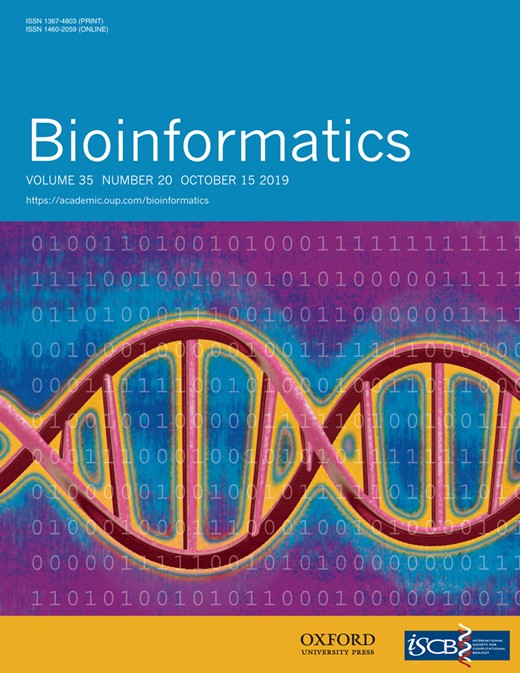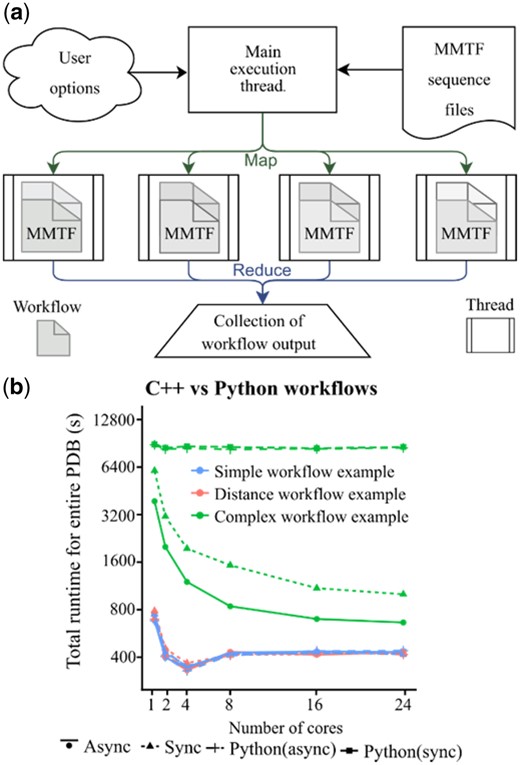-
PDF
- Split View
-
Views
-
Cite
Cite
Jonathan Fine, Gaurav Chopra, Lemon: a framework for rapidly mining structural information from the Protein Data Bank, Bioinformatics, Volume 35, Issue 20, October 2019, Pages 4165–4167, https://doi.org/10.1093/bioinformatics/btz178
Close - Share Icon Share
Abstract
The Protein Data Bank (PDB) currently holds over 140 000 biomolecular structures and continues to release new structures on a weekly basis. The PDB is an essential resource to the structural bioinformatics community to develop software that mine, use, categorize and analyze such data. New computational biology methods are evaluated using custom benchmarking sets derived as subsets of 3D experimentally determined structures and structural features from the PDB. Currently, such benchmarking features are manually curated with custom scripts in a non-standardized manner that results in slow distribution and updates with new experimental structures. Finally, there is a scarcity of standardized tools to rapidly query 3D descriptors of the entire PDB.
Our solution is the Lemon framework, a C++11 library with Python bindings, which provides a consistent workflow methodology for selecting biomolecular interactions based on user criterion and computing desired 3D structural features. This framework can parse and characterize the entire PDB in <10 min on modern, multithreaded hardware. The speed in parsing is obtained by using the recently developed MacroMolecule Transmission Format to reduce the computational cost of reading text-based PDB files. The use of C++ lambda functions and Python bindings provide extensive flexibility for analysis and categorization of the PDB by allowing the user to write custom functions to suite their objective. We think Lemon will become a one-stop-shop to quickly mine the entire PDB to generate desired structural biology features.
The Lemon software is available as a C++ header library along with a PyPI package and example functions at https://github.com/chopralab/lemon.
Supplementary data are available at Bioinformatics online.
1 Introduction
Experimental structures deposited in the Protein Data Bank (PDB) (Rose et al., 2015) have resulted in several advances for structural and computational biology scientific and education communities. Several software packages have been developed using and applying data available in the PDB. Computational structural biology methods are evaluated using several benchmarking datasets mined from the PDB. As one example, for protein-ligand docking, the Astex (Hartshorn et al., 2007), PDBbind (Liu et al., 2017) and DUD-E (Mysinger et al., 2012) sets have been used to predict the 3D coordinates of ligands, rank target activity and discriminate binders from non-binders.
Additionally, the knowledge-based forcefields for protein structure refinement (Chopra et al., 2008) and scoring functions used to evaluate ligand poses in a protein binding site (Bernard and Samudrala, 2009) require extensive feature mining of the PDB. The process for developing these benchmarking sets, structural features for knowledge-based forcefields and scoring functions are non-standard, time-consuming and computationally challenging as it requires significant computational resources to mine different 3D descriptors in the PDB. Development of software for mining these 3D features and use them for machine learning methods is challenging due to the increase in individual entry size as a significant computational cost is needed to parse large text-based formats.
The Macro Molecular Transmission Format (MMTF) (Bradley et al., 2017) was recently introduced to significantly reduce the time required to parse text-based formats traditionally used to store crystallographic data. MMTF requires a fraction of the computation time to read multiple files into computer memory as it uses an encoding format tailored specifically to protein and nucleic acid coordinate data and topology. Specifically, MMTF stores connectivity and chemical grouping data not captured in the PDB and mmCIF formats that are leveraged by Lemon’s data extraction framework. Lemon uses the entire PDB as Hadoop sequence files that are packaged as 578 independent subsets for all MMTF entries and used for the development of highly parallel workflows (Fig. 1). Lemon is the only C++11 software package to our knowledge to parse the Hadoop sequence files natively.
Workflow for Lemon. (a) The overall work follows for the Lemon framework is given. The user provides C++ or Python API Lambda functions which use pre-defined functions to query information about each complex to filter the PDB into a desired subset. (b) A comparison between the C++ and Python benchmarking sets, showing the effect of multiple cores on overall runtime for simple to complex workflows for GCC (asynchronous, ‘Async’ and traditional or synchronous, ‘Sync’ threading)
2 Materials and methods
The Lemon framework uses a paradigm similar to MapReduce developed by Google for mining ‘Big Data’(Dean and Ghemawat, 2004). The user provides a ‘worker’ function that accepts two arguments: an object that represents the structure(s) of the chemical entities, and a string representing the four-letter PDBID. Lemon evaluates this function for all macromolecule entries in a multithreaded manner (Fig. 1a), allowing one to perform any calculation on the structural information encoded by the MMTF file.
The MMTF object given to the user contains biomolecular data at the atomic, chemical group and molecular levels. This includes the position, name, element type and charge of the biomolecular atoms as well as the name, chain, biologic assembly, chemical links and composition type of chemical groups (e.g. protein residues). These features are examples that can be used to create workflows to select and extract desired 3D interactions.
Since a primary goal of the Lemon framework is to create standardized workflows, we have represented an example workflow pictorially (Supplementary Fig. S1). A workflow calculation is performed on the entire PDB database that is stored in its entirety on the user’s local machine. However, users can also choose to pre-filter the database using a query generated on the RCSB website (see section Using an RCSB search in Supplementary Material).
The workflow examples (Listings) are divided into ‘simple,’ ‘distance-based,’ and ‘complex’ categories based on the computational complexity of the workflow. First, the user ‘selects’ chemical groups present in the PDB entry using functions in Lemon for selecting small-molecules, metals, nucleic acids, amino acids, etc. These functions work on the group level by querying the group’s size and composition type. Additionally, it can also include the selection of topological information. Examples for these selectors are given in Supplementary Listings S1–S6.
After obtaining a list of groups, the user can further divide (‘prune’) these groups based on 3D environment, biologic relevance or frequency in the PDB. Lemon provides functions to find biologically identical groups, common groups (see Supplementary Tables S1 and S2) and interacting groups via spatial relationship in 3D. Example lambda functions for ‘pruning’ groups are given in Supplementary Listings S7–S12.
Finally, a workflow will calculate a feature of interest. For example, a user may perform structural alignment to a reference protein (Supplementary Listing S13), calculate a docking score (Supplementary Listing S14) or output statistics on geometries of bonded entities (Supplementary Listings S15–S18). To show case the Python version of Lemon, three example workflows were ported to Python (Supplementary Listings S19–S21). The information obtained from these workflows can then be directly used in machine learning approaches and the development of new structural biology methods.
Lemon also implements two different threading models based on the specifications of the C++ standard library. The first is a traditional (synchronous, ‘sync’) threading approach which divides the PDB into 578 subsets and launches a user-defined number of threads to handle an equal portion of these 578 subsets (e.g. if the user selects two threads each thread will handle 289 subsets). The second is an asynchronous (‘async’) model that schedules 578 threads and executes a given number of them in parallel. Specifically, for async, the next queued thread executes when a thread completes, compared to the ‘sync’ model that requires all threads to complete.
3 Results and discussion
3.1 Querying the PDB takes minutes
To measure Lemon’s execution time, we ran all example listings provided in the Supplementary Material for different levels of multithreading and compiler architectures. The calculations were performed on a community cluster with each node consisting of two 12-core Intel Xeon Gold ‘Sky Lake’ processors (see Benchmarking Lemon in Supplementary Material). There are differences in computational time for a ‘simple,’ ‘distance-based,’ and ‘complex’ workflow (Supplementary Listings S6, S10 and S18) including the time to decompress and parse the MMTF files (Supplementary Fig. S2). The average runtime for all workflows with ‘async’ threading on eight cores (commodity hardware) takes ∼8 min to complete. The Lemon outputs for these queries are shown in Supplementary Figures S6–S8 and Tables S3 and S4.
3.2 Workflow runtime influences threading efficiency
Asynchronous threading is more efficient for ‘complex’ workflows compared to sync threading (Fig. 1b). Theoretically, the sync threading time should be more than async because it needs to wait for other threads to complete. However, the async and sync runtimes are similar for ‘simple’ and ‘distance-based’ workflows (Supplementary Listings S6 and S10) but differ for complex workflow (Supplementary Listing S18) for 2 and 4 cores (Supplementary Fig. S3). The runtime reduces with increase in the number of cores (see 1, 2 and 4 cores in Supplementary Fig. S4). However, for some simple and distance-based workflows runtime increased from 4 to 8 cores (Supplementary Fig. S4). This result may be due to increased performance penalty for atomic (thread locking) operations after completion of each thread. This hypothesis is supported by the continued increase in performance for ‘complex’ operations as they are less likely to become bound.
3.3 Large biomolecules do not affect runtime
Supplementary Figure S4 shows that removal of the largest size PDBs (3J3Q, 3J3Y, 5Y6P) does not significantly reduce the overall runtime for most workflows when compared to the entire PDB (left column in the figure). An exception is the calculation of small-molecule/peptide interactions that requires distance calculations between millions of atoms for large complexes (see Peptides in Supplementary Fig. S4). Hence, Lemon workflows scale with the size PDB entries. This is a significant result given the increase in the amount of large structures in the PDB (RCSB stats page).
3.4 Compiler choice significantly impacts runtime
The selection of the C++ compiler dramatically affects the performance of Lemon (Supplementary Fig. S5). However, the timings shown in Supplementary Figure S5 indicate that there is only a marginal difference between the ‘sync’ and ‘async’ models averaged over all workflows. The GNU Compiler Collection (GCC) version 6.3.0 with ‘sync’ threading compilation outperforms the Intel compiler version 17.0.1.132 with sync threading (Supplementary Fig. S5, green and blue bars). This discrepancy could be a result of GCC’s use of a modern version of the C++ standard library or the specific optimizations performed by this compiler are better for Lemon. Further profiling is beyond the scope of this work and may be addressed in future publications.
3.5 Python is slower than C++ for complex workflows
The data shown in Figure 1b indicates that the Python bindings are just as fast as the C++ version for ‘simple’ and ‘distance-based’ workflows. Complex calculations scale poorly with the number of cores, a result due to the Python global interpreter lock. This underlines the importance of development in the C++ language, potentially after prototyping a complex workflow in Python.
3.6 Code availability
Lemon is hosted on GitHub (see ‘Obtaining Lemon’ in Supplementary Material) along with C++ and Python API documentation on the GitHub page repository. File input and output are provided by the Chemfiles library. A link to the Lemon GitHub repository has been added to the official MMTF webpage on mmtf.rcsb.org.
Acknowledgements
We thank Gerardo Tauriello and Daniel Farrell for MMTF-CPP and Guillaume Fraux for Chemfiles libraries.
Funding
This work was supported by the Institute for Integrated Data Science award; Purdue Instructional Innovation Award; and Purdue Research Foundation and the Department of Chemistry start up award (to G.C.).
Conflict of Interest: none declared.
References




